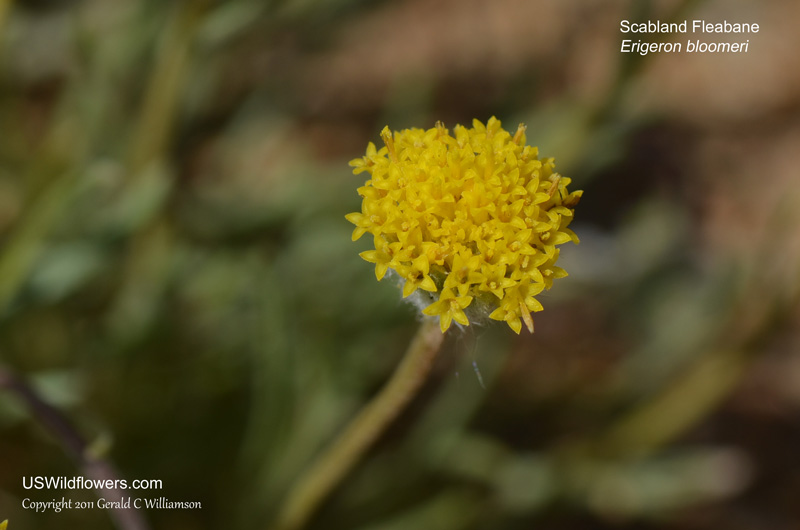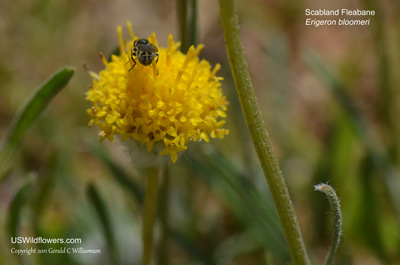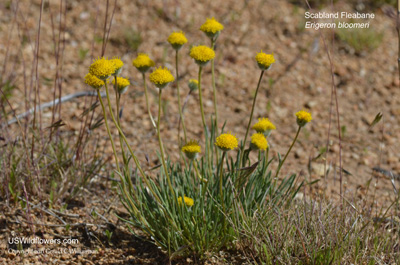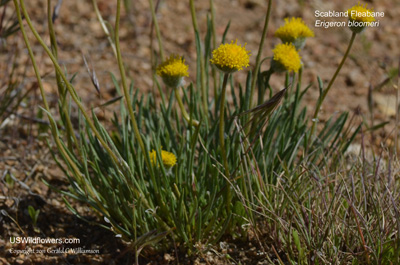Scabland Fleabane, Bloomer's Daisy, Bloomer's Fleabane - Erigeron bloomeri
|
Erigeron bloomeri - Scabland Fleabane, Bloomer's Daisy, Bloomer's Fleabane. Although Scabland Fleabane is the most commonly used common name, I prefer another of the plant's common names - Bloomer's Daisy. The Bloomer's Daisy common name probably won't gain much traction in this digital age, where an Internet search for "Bloomer's Daisy" provides more results for childrens flowered underwear than for this interesting plant. There are three varieties of Erigeron bloomeri (some authorities only recognize two); var. bloomeri has the widest distribution and is the only variety found in Idaho, where these photographs were made.
Erigeron itself is a large and widespread genus, with the USDA Plants Database listing 193 species in North America. Each state of the United States, as well as each territory in Canada, has at least one species of Fleabane present. Most of these are native to the continent, as is the species presented here, Erigeron bloomeri. This species is named for California botanist Hiram G. Bloomer (1819-1874) who collected the plant in Nevada.
There are at least three other members of Erigeron which have rayless, yellow blossoms:
- E. anaphactis - Rayless Shaggy Fleabane - "Shaggy" because it is quite obviously hairy; bristly hairy.
- E. reductus - California Rayless Fleabane - is another yellow, rayless Fleabane, found only in California, as implied by its common name. It has linear stem leaves; the other yellow rayless fleabanes do not have stem leaves.
- E. chrysopsidis var austiniae (syn. E. austiniae) - Sagebrush Fleabane - is a variety of a yellow fleabane which will have no rays or perhaps only vestigial rays. The other varieties of that species have ray flowers. While not as hairy as Rayless Shaggy Fleabane, Sagebrush Fleabane is more apparently hairy than Scabland Fleabane.
Found in:
CA, ID, NV, OR, UT, WA
Leave comments on Erigeron bloomeri at this link. | 
Distribution of Erigeron bloomeri in the United States and Canada:

Map courtesy of The Biota of North America Program.
Map color key
Search Our Database: Enter any portion of the Scientific, Common Name, or both.
Do a general Google search of the entire site:
#ad
 Follow USWildflowers on Twitter
| | Site: Lucky Peak Area, Boise Foothills, Ada County, ID Date: 2011-June-12 | Photographer: Gerald C. Williamson
Nikon D7000
Tamron SP 90MM f/2.8 AF Macro | | This is another of the members of Asteraceae with no ray flowers; its blossom is made up of many tiny yellow disk florets. Blooms June through August | | 
| | Site: Lucky Peak Area, Boise Foothills, Ada County, ID Date: 2011-June-12 | Photographer: Gerald C Williamson
Nikon D7000
Tamron SP 90MM f/2.8 AF Macro | | The stem and leaves of Erigeron bloomeri are variably hairy. Var. nudatus, found in Oregon and California, has mostly glabrous leaves short-hairy stem and tip of linear leaf, but var. bloomeri can be densely hairy, but not bristly like some other rayless yellow Erigeron species. | | Click on the photo for a larger image

| | Site: Lucky Peak Area, Boise Foothills, Ada County, ID Date: 2011-June-12 | Photographer: Gerald C Williamson
Nikon D7000
Tamron SP 90MM f/2.8 AF Macro | | Until you get fairly close to Scabland Fleabane, the plant does not appear to be particularly hairy, especially on the stems, differentiating from other rayless, yellow Fleabanes having no stem leaves. The leaves will probably have a silver sheen due to the hairs on them. | | Click on the photo for a larger image

| | Site: Lucky Peak Area, Boise Foothills, Ada County, ID Date: 2011-June-12 | Photographer: Gerald C Williamson
Nikon D7000
Tamron SP 90MM f/2.8 AF Macro | | Scabland Fleabane has basal leaves and cauline leaves on the stems that rise above the plant. | | Click on the photo for a larger image

|
References used for identification and information:
|
|
| |
| #ad
|
|






